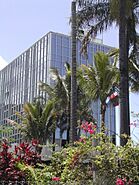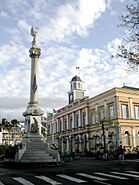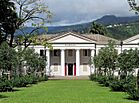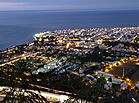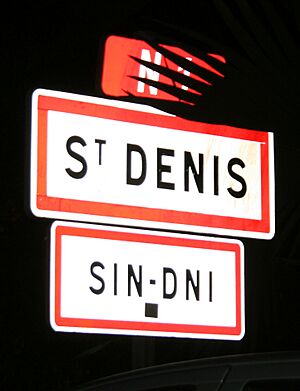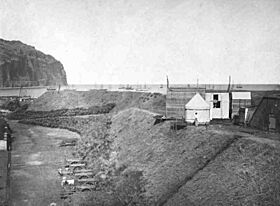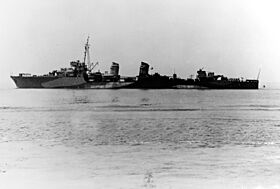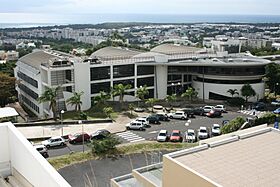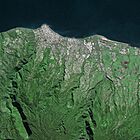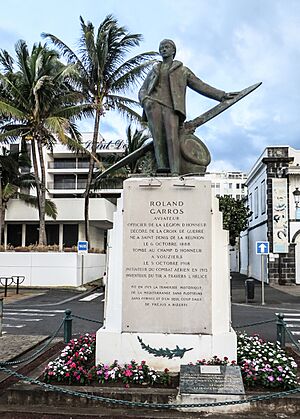Saint-Denis, Réunion facts for kids
Quick facts for kids
Saint-Denis
Sin-Dni (Reunionese Creole)
|
|||
|---|---|---|---|
|
Prefecture and commune
|
|||
|
From top, left to right: Panoramic view of the city from the heights of Bellepierre; cannons at the Barachois waterfront; Saint-Denis Cathedral; Palais de la Source, seat of the departmental council; Saint-Denis's historic city hall and Victory Column; La Réunion's Natural History Museum; city center and Indian Ocean in the evening.
|
|||
|
|||
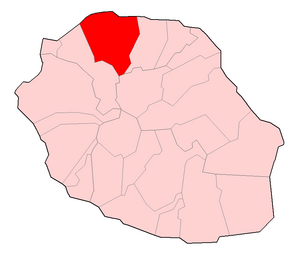 |
|||
| Country | France | ||
| Overseas region and department | Réunion | ||
| Arrondissement | Saint-Denis | ||
| Canton | 4 cantons | ||
| Intercommunality | Nord de la Réunion | ||
| Area
1
|
142.79 km2 (55.13 sq mi) | ||
| • Metro
(2020)
|
547.8 km2 (211.5 sq mi) | ||
| Population
(2021)
|
154,765 | ||
| • Density | 1,083.86/km2 (2,807.20/sq mi) | ||
| • Metro
(Jan. 2021)
|
319,141 | ||
| • Metro density | 582.59/km2 (1,508.89/sq mi) | ||
| Time zone | UTC+04:00 | ||
| INSEE/Postal code |
97411 /97400
|
||
| Elevation | 0–2,276 m (0–7,467 ft) (avg. 23 m or 75 ft) |
||
| Website | Ville-saintdenis-reunion.fr | ||
| 1 French Land Register data, which excludes lakes, ponds, glaciers > 1 km2 (0.386 sq mi or 247 acres) and river estuaries. | |||
Saint-Denis is the capital city of Réunion, a French island in the Indian Ocean. It is located at the very north of the island, near the Rivière Saint-Denis river.
Saint-Denis is the most populated city in all of France's overseas areas. It is also the 19th most populated city in all of France. In 2021, the greater Saint-Denis area had 319,141 people. About 154,765 of them lived in the city itself. The rest lived in nearby towns like La Possession and Sainte-Marie.
Contents
History of Saint-Denis
How Saint-Denis Was Founded
Saint-Denis was started in 1669 by Étienne Regnault. He was the first governor of Bourbon Island, which is what Réunion was called back then. He chose the northern part of the island because it had a large, fertile plain. This area was better for building settlements than the drier west side.
The city was named Saint-Denis after a ship that landed there in 1668. For a while, Saint-Denis and Saint-Paul shared the role of capital. But in 1738, Saint-Denis became the permanent capital of Bourbon Island.
Saint-Denis in the 1700s and Napoleonic Wars
After 1738, work began to build a port in the small bay of Le Barachois. This was meant to replace the port at Saint-Paul. However, the new port was not very safe. Strong winds and tides, plus big waves, made it hard for ships to unload. Cargo had to be brought to shore using a special moving pier.
Later, in the 1800s, a small artificial harbor was built. It protected smaller boats that helped unload cargo. But this harbor was often damaged by cyclones. Eventually, a much larger and safer artificial harbor was built in the 1880s. This new port is now in the town of Le Port, about 15 km (9 miles) from Saint-Denis.
In 1766, Bourbon Island was divided into five areas, and Saint-Denis was one of them. The city's grid-like street plan was officially adopted in 1777. In 1790, Saint-Denis became a commune, which is like a local government area. Its first mayor was Jean-Baptiste Delestrac.
During the Napoleonic Wars, British soldiers took over Saint-Denis on July 8, 1810. The British controlled Saint-Denis and the whole island for almost five years. On April 6, 1815, after a peace treaty, the British officially gave Bourbon Island back to France. This happened in a ceremony in Saint-Denis's main square.
Growth and Development (1815–1860s)
In the 1700s, growing coffee helped Saint-Denis grow. Coffee beans were stored in warehouses in Saint-Denis before being sent to Europe. In the 1800s, after France lost some of its sugar colonies, sugarcane became the main crop in Bourbon. Sugar was the main export, and Saint-Denis continued to grow as the main port for shipping it to Europe.
This time of growth after the Napoleonic Wars brought many new buildings and improvements to Saint-Denis.
- In 1818, a royal college (school) was built in Saint-Denis. It opened in 1819.
- In 1825, a law school was started in Saint-Denis.
- Building the Saint-Denis Cathedral began in 1829 and finished in 1832.
- The Saint-Denis theatre was built in 1835.
- The "Legislative Palace," where the island's government met, was built between 1835 and 1837. Later, in 1855, it became the Natural History Museum of La Réunion.
- In 1843, a racecourse for horse races was opened.
- The old city hall was built from 1846 to 1860.
- The main market, made of iron, was built between 1864 and 1866.
In 1820, a serious illness called cholera reached Saint-Denis. It came from a ship that hid sick people on board. The authorities quickly isolated the sick and moved other people out of the city. This stopped the disease from spreading too much, and 178 people died in the city.
In 1841, the famous poet Charles Baudelaire visited Saint-Denis for 45 days. He was on a trip to India but decided to return to France instead.
On June 9, 1848, news arrived in Saint-Denis that France had become a republic. The island's name was changed to La Réunion. On October 18, 1848, Sarda Garriga, a new leader from Paris, announced that slavery was abolished in Réunion. This took effect on December 20, 1848.
In 1853, the first commercial bank in Réunion, the Banque de La Réunion, was founded in Saint-Denis. It also had the right to print banknotes.
Slow Growth (1860s–1940s)
In 1859, cholera returned to Saint-Denis. A ship carrying workers hid cases of the disease, and it spread quickly. This epidemic killed 863 people in the city and 2,200 across the island.
In the 1860s, the sugar cane industry faced problems. A pest damaged the crops, and it became harder to find workers. Several cyclones also hit the island. In 1868, Malaria arrived in Réunion and became a common disease. These problems, along with the opening of the Suez Canal in 1869 (which made Réunion less important for trade), caused Saint-Denis to grow much slower. The city's population even went down from the 1870s until the early 1920s.
On November 3, 1870, the French Republic was announced in Saint-Denis. That same year, the first telegraph line was set up between Saint-Denis and Saint-Pierre, 110 km (68 miles) away.
In December 1874, a science team from the Netherlands set up a camp at the Barachois seafront. They were there to watch the planet Venus pass in front of the Sun.
A 10.5 km (6.5 miles) railway tunnel was built between Saint-Denis and La Possession from 1878 to 1881. This allowed trains to connect Saint-Denis to the new port at Le Port. This tunnel was the third-longest in the world at that time.
In 1891, some streets in Saint-Denis got electric lights for the first time. In 1896, the first public movie screening happened at the Saint-Denis city hall. In 1900, the first car, a Peugeot, arrived in Saint-Denis.
In 1896, the first Chinese temple in Réunion and France opened in Saint-Denis. In 1905, the Noor-e-Islam Mosque was opened, which is the oldest mosque in France (outside of Mayotte). The first Hindu temple in Saint-Denis was opened in 1917.
Many important people were sent to live in Saint-Denis during this time.
- Queen Ranavalona III of Madagascar lived there for two years starting in 1897.
- Sultan Said Ali bin Said Omar of Grande Comore also lived in Saint-Denis.
- The deposed emperors of Vietnam, Thành Thái and Duy Tân, lived in Saint-Denis until World War II.
- The Moroccan leader Abd el-Krim lived in Saint-Denis from 1926 to 1929.
In 1912, the Léon-Dierx Museum, an art museum, opened in Saint-Denis.
The Spanish flu hit Saint-Denis in April and May 1919. It killed thousands of people. In just one week in 1919, nearly 1,000 people died in Saint-Denis, which had less than 24,000 residents at the time.
Radio services began in Saint-Denis in 1923. The first radio program for the public was broadcast in 1927. The first radio station, Radio Saint-Denis, started in 1929.
In 1938, the old Barachois harbor was filled in to create a large public square.
In June 1940, during World War II, the governor of Réunion supported the Vichy French government. He cut off communication with nearby British areas. The British then blocked ships from reaching Réunion, causing food shortages. A secret resistance movement began to form in Saint-Denis.
After British forces landed in nearby Madagascar, the governor of Réunion decided to declare Saint-Denis an "open city" on September 27, 1942. This meant it would not be defended. On November 28, a Free French destroyer called the Léopard arrived and landed troops without a fight. These troops took over the city and set up a Free French governor. The old governor surrendered on November 30, and Réunion was freed.
City Growth and Modernization (1940s–1970s)
After World War II, Saint-Denis grew quickly and developed a lot. In February 1945, Air France started the first flight route between Paris and Saint-Denis. It took 5 days and 14 stops! In June 1946, the new Gillot airfield (now Roland Garros Airport) opened east of Saint-Denis.
In March 1946, Réunion became an overseas department of France. This meant its services would slowly become like those in mainland France. Campaigns to get rid of malaria started in 1949. Malaria had slowed population growth, but with its eradication by 1967, the island's population grew very fast.
All these changes, plus people moving from the countryside to the city, made Saint-Denis expand rapidly. The city's population more than doubled between 1954 and 1967.
In 1956, construction began on a major road connecting Saint-Denis and La Possession. This new road, finished in 1963, made travel much easier. It was later made into a 4-lane highway between 1973 and 1976.
In 1957, a large modern hospital, the Centre hospitalier Félix-Guyon, opened in Saint-Denis. This was part of the improvements from Réunion becoming an overseas department.
In July 1959, Charles de Gaulle, the President of France, visited Saint-Denis. It was the first time a French head of state had visited the city.
In 1961, the first modern hotel and the first supermarket opened in Saint-Denis. However, the city's infrastructure was still behind mainland France. Many people lived in poverty, and housing was a big problem.
A law was passed in 1964 to help clear slums and build new public housing. In 1965, construction began on large public housing projects in the Le Chaudron neighborhood, east of the city center. These projects, finished in 1973, provided homes for nearly 10,000 people.
In December 1964, the first TV station in Réunion opened in Saint-Denis. A university campus, which later became the University of Reunion Island in 1982, also opened in Saint-Denis between 1964 and 1970. In August 1967, the first nonstop commercial flights between Saint-Denis and Paris began. The city's new modern city hall was built in the 1970s. Saint-Denis also hosted the first Indian Ocean Island Games in 1979.
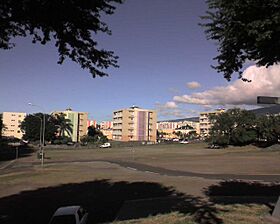
Geography of Saint-Denis
Saint-Denis is located at the northern tip of Réunion Island. It used to be the main port, but a new, artificial harbor at Le Port replaced it in the 1880s. This was because the winds and tides at Saint-Denis were too unpredictable. The city also includes some of the island's mountains, with a highest point of 2,276 meters (7,467 feet) within the city area.
Saint-Denis has many different neighborhoods, including:
- Le Barachois
- Bellepierre
- Bois-de-Nèfles
- La Bretagne (Le Cerf)
- Le Brûlé
- Les Camélias
- Centre-ville (City Center)
- Champ-Fleuri
- La Montagne (Le Colorado, Ruisseau Blanc, Saint-Bernard)
- Montgaillard
- La Providence
- La Rivière Saint-Denis (La Redoute)
- Ruisseau des Noirs
- Saint-François
- Saint-Jacques
- Sainte-Clotilde (Le Butor, le Chaudron, Commune Prima, Domenjod, Le Moufia)
- La Source
- La Trinité
- Vauban
Climate in Saint-Denis
Saint-Denis has a tropical monsoon climate. This means it has two main seasons:
- A hot and humid wet season from December to April.
- A very warm, less humid dry season for the rest of the year, especially from June to October.
During the wet season, tropical cyclones (big storms) often affect the city.
Population of Saint-Denis
Saint-Denis is the most populated city in France's overseas departments. The number of people living in Saint-Denis has grown a lot since 1954. Both the city itself and the larger metropolitan area have seen their populations more than triple in 67 years. However, the population has grown slower in the 21st century compared to the 20th century.
|
|
||||||||||||||||||||||||||||||||||||||||||||||||||||||||||||||||||||||||||||||||||||||||||||||||||||||||||||||||||||||||||||||||||||
In 2015, most people (81.1%) in the Saint-Denis greater area were born in Réunion. About 11.1% were born in mainland France. The rest came from other places like Mayotte, other French overseas areas, or foreign countries. Many foreign-born residents came from Madagascar, the Union of the Comoros, and Mauritius.
Transportation in Saint-Denis
The closest airport is Roland Garros Airport. It is about 7 km (4 miles) east of the city in Sainte-Marie, Réunion. This is Réunion's main international airport. Air Austral is a local airline that flies from here. Several other airlines also serve the airport. Saint-Denis also has a good road network.
On March 15, 2022, an aerial tramway (like a cable car) called Papang started operating. It is 2.7 km (1.67 miles) long and has 5 stations. It connects the neighborhoods of Le Chaudron and Bois-de-Nèfles.
Mayors of Saint-Denis
Here are some of the people who have been mayor of Saint-Denis:
- 2020–present: Ericka Bareigts
- 2008–2020: Gilbert Annette
- 2001–2008: René-Paul Victoria
- 1994–2001: Michel Tamaya
- 1989–1994: Gilbert Annette
- 1969–1989: Auguste Legros
Culture and Attractions
- Léon Dierx Museum: An art gallery and museum.
- Jardin de l'État: Public gardens that also have a natural history museum.
- Le Barachois: A park along the seafront.
- La Roche Écrite: A mountain peak about 15 km (9 miles) south of the city. It offers amazing views over Saint-Denis.
- Brasseries de Bourbon: A local brewery.
Places of Worship
In Saint-Denis, you can find many places of worship. Most of them are Christian churches, like those of the Catholic Church and Assemblies of God. There are also Muslim mosques.
Education in Saint-Denis
The University of Reunion Island has 6 campus sites in Saint-Denis. About 15,000 students attend each year. The courses follow European standards for university education. There is also an engineering school. The main language of instruction is French. The university has connections with schools in mainland France.
The city also has many elementary schools in different areas.
Economy of Saint-Denis
IBM has an office in Saint-Denis. The island is working to become a digital hub for nearby African countries. It uses two undersea cables for fast internet connections. This focus on digital services could change the island's economy, which currently relies a lot on sugar farming. The university in Saint-Denis offers programs to teach young people digital skills. New businesses are also starting up to create software for airlines.
International Connections
Saint-Denis, Réunion is connected to other cities around the world. These are called sister cities or twin towns.
Saint-Denis is twinned with:
Famous People from Saint-Denis
Many notable people have lived in or are connected to Saint-Denis:
- Abd el-Krim: A Moroccan leader who lived in Saint-Denis from 1926 to 1947.
- Bảo Vàng: A Vietnamese prince who was born and lived in Saint-Denis.
- Félix Guyon (1831–1920): A famous doctor who specialized in urology.
- Édouard Hervé (1835–1899): A journalist and academic.
- Juliette Dodu (1848–1909): A resistance fighter during the war of 1870.
- Ambroise Vollard (1866–1939): An art dealer and gallery owner.
- Raymond Vergès (1882–1957): A former mayor of the town.
- Roland Garros (1888–1918): A famous aviator (pilot).
- Raymond Barre (1924–2007): A politician.
- Daniel Sangouma (1965): A sprinter (runner).
- Gérald De Palmas (1967): A singer.
- Surya Bonaly (1973): An international Olympic figure skater.
- Willy Grondin (1974): A football (soccer) player.
- Daniel Narcisse (1979): An international handball player.
- Valérie Gauvin (1996): A football (soccer) player.
- Jonathan Kievit (1998): A DJ and musician known as Imanu.
See also
 In Spanish: Saint-Denis (Reunión) para niños
In Spanish: Saint-Denis (Reunión) para niños





